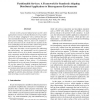Free Online Productivity Tools
i2Speak
i2Symbol
i2OCR
iTex2Img
iWeb2Print
iWeb2Shot
i2Type
iPdf2Split
iPdf2Merge
i2Bopomofo
i2Arabic
i2Style
i2Image
i2PDF
iLatex2Rtf
Sci2ools
HPDC
2002
IEEE
2002
IEEE
Partitionable Services: A Framework for Seamlessly Adapting Distributed Applications to Heterogeneous Environments
Several recently proposed infrastructures permit client applications to interact with distributed network-accessible services by simply ”plugging in” into a substrate that provides essential functionality, such as naming, discovery, and multi-protocol binding. However, much work remains before the interaction can be considered truly seamless in the sense of adapting to the characteristics of the heterogeneous environments in which clients and services operate. This paper describes a novel approach for addressing this shortcoming: the partitionable services framework, which enables services to be flexibly assembled from multiple components, and facilitates transparent migration and replication of these components at locations closer to the client while still appearing as a single monolithic service. The framework consists of three pieces: (1) declarative specification of services in terms of constituent components; (2) run-time support for dynamic component deployment; and (3) pl...
Distributed And Parallel Computing | Facilitates Transparent Migration | HPDC 2002 | Infrastructures Permit Client | Partitionable Services Framework |
| Added | 14 Jul 2010 |
| Updated | 14 Jul 2010 |
| Type | Conference |
| Year | 2002 |
| Where | HPDC |
| Authors | Anca-Andreea Ivan, Josh Harman, Michael Allen, Vijay Karamcheti |
Comments (0)

